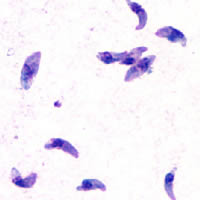Toxoplasma
| Toxoplasma gondii | |
|---|---|

| |
| T. gondii tachyzoites | |
| Scientific classification | |
| Kingdom: | |
| Phylum: | |
| Class: | |
| Subclass: | |
| Order: | |
| Family: | |
| Genus: | Toxoplasma
|
| Binomial name | |
| Toxoplasma gondii | |
Toxoplasma gondii is a protozoan parasite that can infect almost all warm-blooded animals, including humans.[1][2]
In humans, it is one of the most common parasites.[3] Blood test show that up to a third of the world population has been or is infected with T. gondii. Infection rates differ greatly from country to country.[4]
Although mild, flu-like symptoms occasionally occur during the first few weeks, infection with T. gondii generally produces no symptoms in healthy human adults.[5] But in infants, HIV/AIDS patients, and others with weakened immunity, infection can cause serious and occasionally fatal illness (toxoplasmosis).[2][5]p77
Infection in humans and other warm-blooded animals can occur
- by eating raw or undercooked meat containing T. gondii tissue cysts.[6][7]
- by drinking water or eating anything contaminated with oocysts.[8] in the faeces of an infected animal.[7]
- from a blood transfusion or organ transplant
- or by transmission from mother to foetus across the placenta.[7]
The parasite can only sexually reproduce in the intestines of members of the cat family (felids).[9] Felids are therefore the definitive hosts of T. gondii, with all other hosts defined as 'intermediate hosts'.
References
[change | change source]- ↑ Weiss, Louis M. & Kami Kim, eds. 2011. Toxoplasma gondii: the model Apicomplexan: perspectives and methods. Academic Press/Elsevier, London, p49.
- ↑ 2.0 2.1 Dubey J.P. 2010. Toxoplasmosis of animals and humans. 2nd ed, CRC Press. ISBN 978-1-4200-9237-0
- ↑ "CDC – About Parasites". Retrieved 12 March 2013.
- ↑ Pappas, Georgios; Roussos, Nikos; Falagas, Matthew E. (2009). "Toxoplasmosis snapshots: global status of Toxoplasma gondii seroprevalence and implications for pregnancy and congenital toxoplasmosis". International Journal for Parasitology. 39 (12): 1385–94. doi:10.1016/j.ijpara.2009.04.003. PMID 19433092.
- ↑ 5.0 5.1 "CDC Parasites – Toxoplasmosis (Toxoplasma infection) – Disease". Retrieved 12 March 2013.
- ↑ Tissue cyst = group of cells with a hard shell around them
- ↑ 7.0 7.1 7.2 Tenter, Astrid M.; Heckeroth, Anja R.; Weiss, Louis M. (2000). "Toxoplasma gondii: from animals to humans". International Journal for Parasitology. 30 (12–13): 1217–58. doi:10.1016/S0020-7519(00)00124-7. PMC 3109627. PMID 11113252.
- ↑ Oocyst: a hardy, thick-walled spore able to survive for long periods outside a host. The zygote develops within the spore, which acts to protect it during transfer to new hosts. This method is found in some Apicomplexa.
- ↑ Dubey, JP (2009). "History of the discovery of the life cycle of Toxoplasma gondii". International Journal for Parasitology. 39 (8): 877–882. doi:10.1016/j.ijpara.2009.01.005. PMID 19630138.
